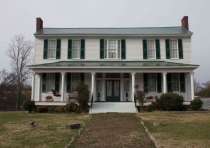
The Wilkinson family, like many southern families, suffered during Union occupation, seeing their property confiscated while losing loved ones to the vicissitudes of war.
In 1830, Francis H. Wilkinson built a substantial Federal Style home with slave labor on a slight rise just outside Pulaski, Tennessee. When the Civil War came, Pulaski, which was located on the Nashville & Decatur Railroad, witnessed much military activity as Union and Confederate armies contended for control of the rail system in southern Tennessee. In 1862, Union troops moved in as an occupation force, and the Wilkinson family initially hid from the newcomers in a secret room above their kitchen. Eventually, Union Army officers occupied the house and it became headquarters for a regiment of United States Colored Troops (USCT) encamped on Fort Hill directly west of the house. USCT soldiers were constantly coming and going around the house, with the family living upstairs while Union officers occupied the downstairs rooms as living quarters and offices for management of regimental affairs. Although strongly garrisoned, Pulaski did not completely escape military action over the course of the war. During his raid on Pulaski in September 1864, Confederate General Nathan Bedford Forrest directed his artillery to lob cannon balls over the Wilkinson house at Union soldiers entrenched on Fort Hill as a deception before withdrawing eastwards to target the Nashville & Chattanooga Railroad. Forrest had prudently decided that Union positions covering the town were too strong to attack. Francis Wilkinson’s son-in-law, William James McNairy, a doctor who joined the Confederate Army, was decapitated during the Battle of Chickamauga in September 1863. The Wilkinson clan typified many southern families that suffered during Union occupation and confiscation of their property while losing loved kinfolk to the vicissitudes of war.
Tools
Key Facts
- In 1830, Francis H. Wilkinson used slave labor to build the Federal Style home just outside Pulaski
- In a secret room, the family hid from Federal occupiers, before living upstairs while officers and USCT regiments used the rest of the house



